Twigs and Branches - 2022 - January to May
A web of present and past events
These short articles are written to highlight connections of the plants, history and lore of the Eloise Butler Wildflower Garden with different time frames or outside connections. A web of intersections.
Visit the Garden. Don't miss the season!
This week (May 15 - 21) you can still see some of the Trilliums in bloom. There are strong displays of Marsh Marigold in the wetland and on the surrounding hillsides the swaths of the Toothworts, both the Cut-leaved and the Two-leaved, are simply outstanding. Clumps of Virginia Bluebells, Large-flowered Bellwort and False Rue Anemone, along with many Wood Poppies will treat your eyes. Swamp buttercups are in flower and the Swamp Saxifrage is budding out. Fern fiddleheads are unfolding everywhere. A special treat is yours if you find the clump of Yellow Trillium on Geranium Path. This plant is not native to our state but instead to the Smoky Mountains. Martha Crone first brought it to the Garden in 1946. It has been replanted several times and is maintained as an historic Garden plant. The clump this year has expanded and will be magnificent this week.
Below: One of many expanses of Two-leaved Toothwort in the Garden on May 14, 2022.
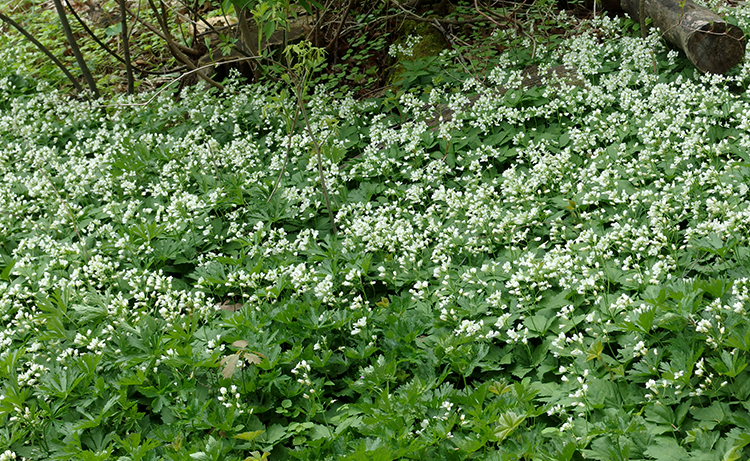
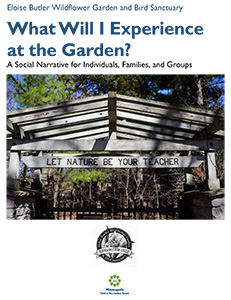
If you venture into the Upland you will see that parts of some hillsides were burnt this spring. The Shooting Star is ready to bloom there - usually the first upland flower to bloom after a burn. The Redbud and the Wild Plums were in full bloom on the 14th.
There are plenty of activities for you also. The Saturday birding group is in session, every Saturday at 8:30. The Garden naturalists do walks every day, topics varying. Garden Storytime for kids is every Thursday at 10 AM. If you have children and have never visited the Garden with them, the Garden staff has prepared an introduction for them titled "What Will I Experience." It also incorporates rules and expectations.
Please see the Eloise Butler Wildflower Garden web site at MPRB for more information.
May 2022: People flock to see it!
In a typical year the most sought after flower in the Wildflower Garden will begin to bloom sometime in the first two weeks of June - our state flower, the Showy Lady’s-slipper (Cypripedium reginae). Its first bloom has been as early as May 24 and as late as June 28. With this year's slow spring, we must wait and see but calls have already been received from anxious visitors about when it will bloom this year. Martha Crone said “To have missed its flowering season in the Garden seems almost to lose part of summer.”

The Showy Lady's-slipper plant is indigenous to this area of Wirth Park and has also been planted numerous times in the Wildflower Garden. In Eloise Butler’s time she was able to help herself to nearby plants. In recent years you cannot do that so the acquisitions have been rescued plants from road construction and from a Showy Lady’s-slipper rescue enclave in northern Minnesota.
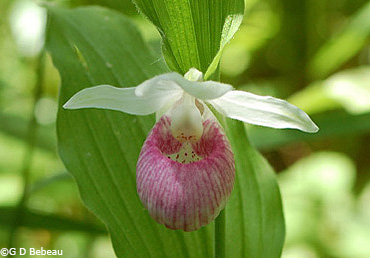
Eloise Butler named an area north of the current Garden space “Lady’s-slipper Path” in which she located several other members of the Cypripedium genus. This area was part of the Wildflower Garden at the time. Today the Showy is found in the wetland along Lady’s-slipper Lane and near the boardwalk bridge.
Eloise wrote in 1911: “The greatest prize of the swamp is our state flower, the showy Cypripedium, the pink and white Lady’s-slipper, a member of the orchid family. No flower, wild or cultivated, is more magnificent than this. The plant is the tallest of the genus and has the broadest leaves and the largest and most beautifully tinted flowers, often bearing two on one stalk. Only North American Indian ladies wear slippers of this style, and the precise always call them moccasins. Goddesses, also, must have approved of this kind of footgear, for the scientific name, Cypripedium, means Venus’ boskin.”
Links:
Details and more photos of the Showy Lady's-slipper. Photo above - G D Bebeau
Lady's-slippers rescued in northern Minnesota.
Eloise Butler consults a Medium:
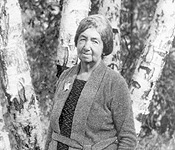
Miss Butler wrote often about her uncanny ability to find plants she was searching for and to answer reflexively, questions she knew nothing about. She writes:
The following summer, merely out of curiosity, as I have no belief in spiritistic phenomena, I had a “sitting” with an alleged “Medium,” who was visiting the family. Among other queer remarks she said, “When you want a plant, you always find it. This is the cause of it: You have two friends, botanists, who are deeply interested in your work. It is as if they put their hands on your shoulders and pushed you toward the right place.” Then I laughed, saying, “That explains my experience with Leatherwood.” The medium, by the way, knew nothing about my work.
Read more about that leatherwood and other experiences in Occult Experiences of a Wild Gardener.
Mosquito Repellant:

To deter mosquitos you should avoid things that give off red and orange light, because mosquitos are attracted by those light frequencies in the presence of carbon dioxide. Flesh tones give off that color light and we exhale carbon dioxide, making humans prime targets for many disease transmitting mosquitos. (1)
Mosquito repellants can be natural or synthetic and most of us are familiar with the man-made versions. These were developed by trial and error. No one really knew why they worked. Witness Clinton Odell sitting in a chair out in Eloise Butler Wildflower Garden in the evening testing his companies repellant concoctions.(2) Nature had already solved that problem. So, what is it that makes natural plant repellants effective?
A recent study has uncovered the clue.(3) Mosquitos have over 100 receptors on their nerve cells. Those of what are called the “OR” type are attuned to warn the insect away. One of most potent plants that has been used as a repellant for thousands of years is the Dalmatian Chrysanthemum, aka Pyrethrum, (Tanacetum cinerariifolium). An extract of the dried flower gives a molecule called “pyrethrum” which has now been discovered to activate a certain nerve cell receptor (named OR31) which many disease bearing mosquitos have. When this receptor senses pyrethrum the mosquito flinches away.
Below: Dalmatian Chrysanthemum. Photo University of Mississippi Extension Service.
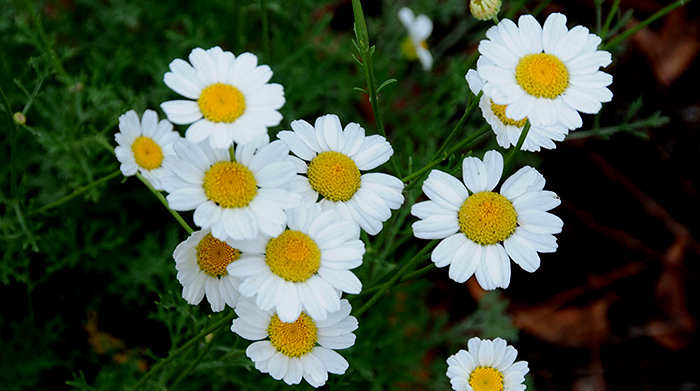
This discovery could lead to super enhanced repellants. More research is being done to determine which other plant molecules have a similar effect on certain receptors. Pyrethrum has a repellant effect on a number of insects but it does not harm pollinators, or other insects visiting the flowers as the active chemicals are locked in the seeds until dried.
There are two common plants in our local natural environment which are known to have repellant properties. One is another Tanacetum - Tansy (Tanacetum vulgare) and Lopseed, (Phryma leptostachya).
Historically, in the Wildflower Garden, mosquitos were always a problem. Eloise Butler kept her version of repellant on hand in the Garden back in the day when there wasn’t a Metropolitan Mosquito Control District to fight the critters. This was written in a local newspaper: The curator’s office is equipped with anti-mosquito fluid so that those who can stay away from the woods for fear of the over-enthusiastic mosquito, need have not fear. If the visitor’s epidermis is unusually thin, he can get a “face and hand wash” free and after the fluid has been applied the mosquito will break all aerial records getting away from him.
Martha Crone frequently noted how bad they were, not just at Eloise Butler's memorial ceremony in 1933 when Theodore Wirth complained about them, but especially in the years 1938 to 1941 when they were a plague. In 1953 she purchased a sprayer and within two years wrote that the mosquitos were under control. We do not know what she used for insecticide but when Clinton Odell had complained to Park Board Superintendent Charles Doell about the mosquitoes in 1949, Dowell wrote back that he knew the Garden had mosquito problems for many years but “Frankly, I am a bit afraid of the extensive use of DDT as yet,” and went on to list his concerns. We know about DDT now. One of the first uses of the Friends annual donation to Garden support for equipment was for a backpack mist sprayer for Gardener Ken Avery in 1965. We do not know what chemical he used either but in 1991 Gardener Cary George could still state that the mosquito hatch was the worst in 15 years.
NOTES:
1. Research study led by University of Washington neurobiologist Jeff Riffell, in Nature Communications. PDF abstract of study at this link.
2. Interview with Martha Crone, published Winter 1978, The Fringed Gentian™, Vol. 26 No. 1
3. Research study led by Duke University neurotoxicologist. PDF abstract of study at this link.

Garden display at Sumner Library
A display show-casing the Eloise Butler Wildflower Garden has been established at the Sumner Branch of the Hennepin County Library System. This project was originated by Friends President Jennifer Olson and was installed by her and two other Friends - Marijane Tessman and Maggie Tuff.
The spring display highlights the spring flowers, a bit of Eloise Butler history and a set of five glass tiles featuring spring wildflowers from Judy Remington's glass works.
Stop in anytime to see this and if you wish to volunteer some time to help with the seasonal rotation of the display please contact Jennifer (link deleted)
The Sumner Library is located at 611 Van White Memorial Blvd, (at Olson Highway), Minneapolis. Image - Judy Remington at the display. Photo by Jennifer Olson.
The Wildflower Garden opened this past blustery weekend with the paths clear of snow and ice, bar a bit at the fence. Three of the five early bloomers have a few representatives in bud or blooming - Snow Trillium, Hepatica and Skunk Cabbage. Although this is a slightly retarded start to the season, once the weather warms there will be a scramble to catch up to the calendar by the first week of May.
This link tells you more about the five early bloomers.
Snow Trillium in bud on April 16, 2022.

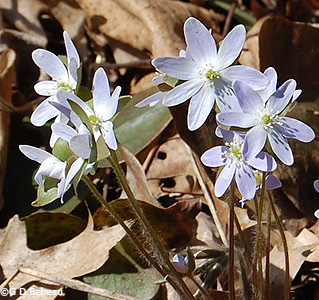
April, 2022: Hepatica:
Of all the early ephemeral spring flowers that we wait to see, surely the Hepatica is near the top of our lists. The small flowers have no corolla or petals but instead the 6 to 12 sepals are colored in shades of pure white to pinkish and even to bluish blush. They poke up early above their old leaves which have over-wintered and taken on a bronze tone. New leaves will form after flowering.
The Hepatica was not present in this section of Glenwood Park when the Wildflower Garden was established, so Eloise Butler imported them from various places around the city and state beginning in 1907. In her time a common name for the plant was “Liverwort” and the plants were placed in the “Crowfoot” family, which today is called the “Buttercup” family. Eloise provides this description:
"The large Crowfoot family is without strongly marked characters. Its plants have usually an acrid taste; the leaves are generally more or less cut or divided; the corolla is often wanting, and, when this is the case, the calyx is colored like a corolla; the stamens are numerous; the pistils vary in number from one to several; and all the parts of the flower are distinct or unconnected.
All these points may be verified in the hepatica, or liverleaf, now in bloom along the river banks. It seems somewhat incongruous to associate a name so musical and a flower so beautiful with anything so prosaic as the liver. Yet hepatica is “liver” in Greek, and some herbalist, long ago, made the comparison, when he saw the three-lobed leaf. The leaves endure through the winter and their rich tints of bonze and purple garnish the tuft of lovely flowers varying through all shades of blue and lilac to white. The lighter tones are found in the older and more exposed flowers.
Just under the flower, and separated from it by a very short stem, are three green leaves or bracts, as leaves on flower stems are technically named - which exactly imitate a calyx, thus fooling the unwary. When the flowers go to seed, new leaves appear. Several plants get their flower work done early, before they are shaded by the leaves, which unfold later to prepare the food for the next year’s flowers and seeds.
The hepatica is closely allied to the anemones. Two species are found in Minnesota - one with sharp-lobed and one with round-lobed leaves. The sharp-lobed species only, is indigenous to Minneapolis; but both have been planted in the wild garden in Glenwood Park." (Published in the Minneapolis Sunday Tribune April 28, 1911).
Eloise had a favorite spot for her Hepatica located along the current woodland Geranium Path. When Martha Crone was curator, she resurrected this extensive hillside, known as “Hepatica Hill,” making frequent plantings of Hepatica, including in just two years, 550 Sharp-leaved in 1947 and 1,350 in 1947. Over time a large number of these plants die out to do changing conditions, especially as the result of the loss of tree canopy from Dutch Elm Disease. In 2005 our current Garden Curator, Susan Wilkins, began a replanting and restoration of Hepatica Hill.
Below: Hepatica Hill on April 16, 1955. Photo by Martha Crone.
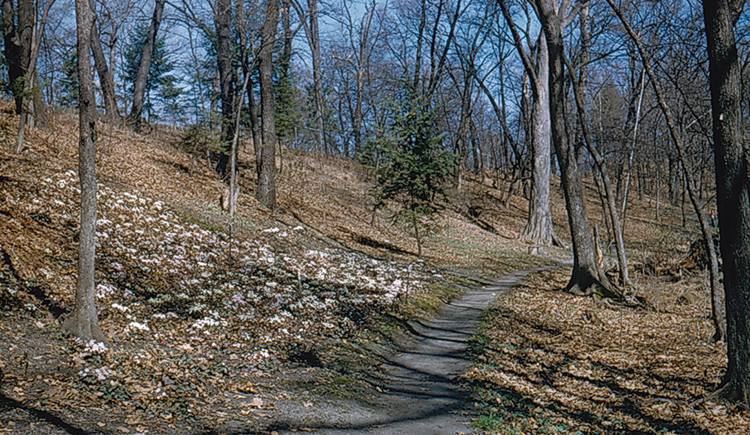
More technical details are on our Hepatica plant information sheet.
Contemporary photos are by G D Bebeau.
The historical earliest known bloom date noted in the Garden was March 29th and the latest was April 27.
Martha Crone mentioned her extensive planting on Hepatica Hill as early as her 1946 Annual Report to the Board of Park Commissioners.
April, 2022: Out of Thin Air:
A plant census of the future.
Have you read about the weekly testing DNA testing of water samples for Covid variants?
If so, then taking a DNA sample from thin air might not seem so far-fetched. Beginning with Eloise Butler and her fellow teachers in 1907, a periodic census of plants in the Wild Flower Garden has been done by people methodically and repetitively visiting the site to tabulate what’s found there. The most recent was in 2015, What if all that work could be done with an air sample??
In our Fall/Winter newsletter we presented an article on what animals had been caught on night cameras in the Wildflower Garden. But an animal had to walk be the camera to by counted. Recent air sample studies are showing that current techniques not only catch a significant percentage of animals known to be present in the vicinity of the test but also many that physical sampling missed. All living things give off DNA to the air. Can a census of living plants be far behind?

Above: Graphic of air sampling for dna courtesy of The Economist.
What to read more? This link takes you to a recent short summary from Scientific American (SA).
For more detail this link takes you to one of the research papers of Elizabeth Clark covered in the SA article.
March 16, 2022: Rarities in 3 spring ephemerals:
Three of the beautiful ephemeral spring flowers at Eloise Butler had an historical rarity that could be viewed in the Garden in years past.
First was the double flowered Bloodroot. It is believed that they came from former curator Martha Crone's home garden in 1988 when her family donated a number of her plants to the Garden at the time Martha entered a nursing home. The photo was taken May 1, 2000 in the Garden by G. D. Bebeau.
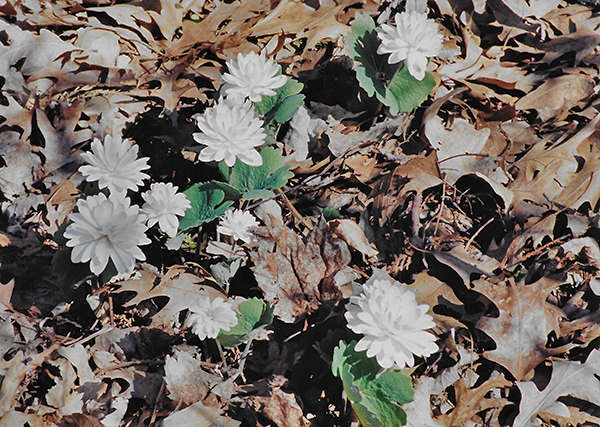
They are a naturally occurring native rarity but not common. In Martha's correspondence are letters noting that she sent these plants from her home garden to several friends. The double has the same leaf and structure as the native variety, but the excess of petals nearly hides the yellow color of the stamens.
A nursery trade developed hybrid has been available as Sanguinaria canadensis - ‘Multiplex.' For details of the normal bloodroot, which has an extensive history of folk medicine and pharmacological use, not to mention being somewhat toxic, see our info sheet.
Next are Trilliums with 4 flower parts instead of the normal 3. These are also natural rarities.
Our second example is the white Large-flowered Trillium, Trillium grandiflorum. On May 6, 1941 Curator Martha Crone was planting some Large-flowered Trillium when she noticed one nearby that was odd. She wrote in her Garden Log “Noted west of office a Trillium with 4 petals, 4 sepals, 4 leaves, 8 stamens and 4 parted stigma.” Unfortunately we do not have a photo of that, but of the next example we do. Info sheet for Large-Flowered Trillium.
The third plant is the Snow Trillium, Trillium nivale. On April 20, 1953 Martha Crone received 12 of these 4-parted rarities from Mrs. E. H. Cummings in Preston, MN. Preston is in southeast Minnesota, the only part of the state where the Snow Trillium is native. Info sheet for Snow Trillium. The photo is from a Kodachrome of April 22, 1957 taken in the Garden by Martha Crone.
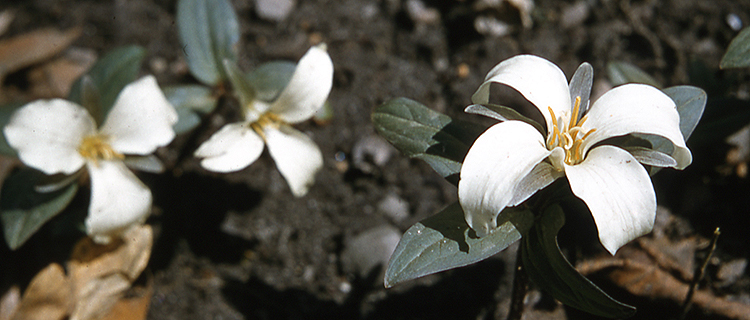
If you are looking forward to seeing blooms of these three plants (the normal variety) this spring, here are the historical early and latest first bloom dates. Even though the Garden will not open until April 15, with a not-to-early spring you may see all three, but on different visits as they rarely overlap.
Bloodroot: April 1 to April 28.
Large-flowered Trillium: April 16 - May 22.
Snow Trillium: March 22 to April 22.
March 4, 2022: Jumping Worms - Gardener's beware:
A recently arrived invasive pest is making inroads in Minnesota and the Twin City area - the Asian Jumping Worm (Amynthas species). We have tolerated the non-native European earthworm for some time but this creature is much more destructive. It lives in the upper few inches of topsoil converting a stable surface to one of highly erodible granular soil. There are areas in the eastern states where entire hillsides have eroded away.

The staff at the Eloise Bulter Wildflower Garden is taking extensive steps to prevent the importation of the worm. The Friends Invasive Plant Action Group does likewise when doing their work. No soil is brought in on tools or feet. Plants brought in are root washed before planting, etc.
You can do your part by being aware when you purchase plants and mulch for your use. Start by using this link to the Minnesota DNR webpage on the worm. There are a number of links on this page on how to identify the worm or it’s presence, how to report it and what preventive steps should be taken.
February 14, 2022: Update on Black Birding

In our fall 2020 newsletter Lauren Husting wrote about Black scientists and Black Birders Week. As a followup to that we are posting an article originally published in Scientific American in which 3 co-organizers of the first Black Birders Week speak of their experiences and why they love the natural world. Read it here.
In a run-up to the 2nd Black Birders Week in 2021 Wilson Ornithological Society held a symposium on Black Birders: “Exploring Wild Places and Confronting White Spaces in Ornithology.” Our second article is a short summary of the life stories of the participants in this session. Deja Perkins makes it into both posts. Read it here.
As an historical anecdote, the woman who began the bird feeding station in Theodore Wirth Park and led birding jaunts in the Park in the 1930s and 1940s and was president of Minneapolis Audubon, Lulu May Aler, was a member of Wilson. Read more about Miss Aler here.
February 5, 2022: Do we need another invasive plant pest?
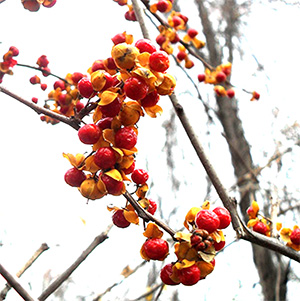
No, but we have one invading our parks and woods. It’s called Oriental Bittersweet (Celastrus orbiculatus). It has lovely berries and, as seems to be the case so often, was viewed as a nice ornamental plant to have in the landscape. Like Common Buckthorn, those berries are super spreaders. The plant can grow 15 feet per year and reach stem thickness of 5 inches. As it climbs trees in search of light, it girdles the tree and eventually smoothers it. In 2015 Jim Proctor of the Friends Invasive Plant Action Group reported finding it in Wirth Park near the Garden. It is now known in a number of Hennepin County Parks - but there is still a chance to eliminate it unlike Buckthorn which can only be controlled.
The plant was brought into North America in the late 19th Century. It is now endemic and out of control in a number of eastern states. The University of Minnesota Plant Checklist states it was first collected in Minnesota in 2002 in a Hennepin County Park. The Minnesota DNR plant survey from 2019 reports it in Anoka, Hennepin and Ramsay Counties. The EDDMapS site reports more counties but until the DNR confirms that, it could be a case of mistaken identity.
Here is the current distribution map posted by EDDMapS.

So - how do you distinguish it from our native American Climbing Bittersweet (Celastrus scandens)?
This quick chart from the Minnesota Department of Agriculture gives the basics. Then refer to this comprehensive key from the USGS.
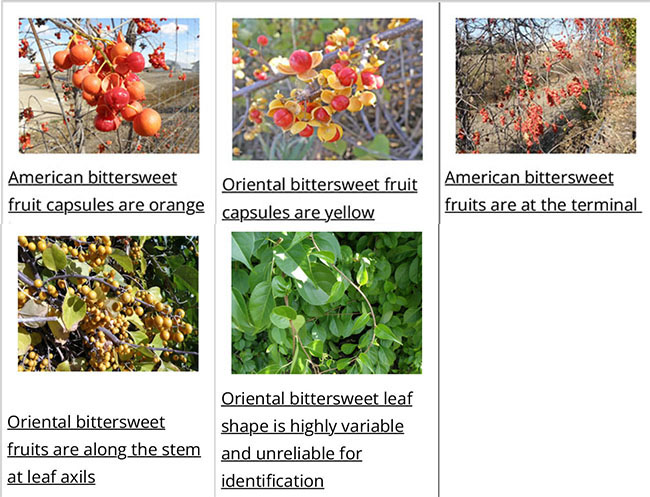
Oriental Bittersweet was classified as a noxious weed in Minnesota in 2011. Volunteers can help find and mark this plant for eradication. Winter is the best time when the fruits can be identified. Three Rivers Park District runs such a program. Emily Dunlap runs the program there. Findings can also reported directly to the Minensota DNR at "Report a Pest" and also individuals can log it on the EDDMapS site.
 January 14, 2022: Do pine cones grow on willows?
January 14, 2022: Do pine cones grow on willows?
NO. You have been deceived by the snug tiny house of the gall gnat midge larva who is waiting out the winter in comfort. For a look at the the inside of the house, the occupant and how it survives the winter --
Read on.
Your Preferences: Subscribers to this email list have four email options to chose from: 1) To receive Twigs and Branches or not; 2) to receive our newsletter by email or not; 3) to receive membership renewal notice by email or not; and 4) to receive FIPAG emails or not. If you wish to modify any of these individual choices, use the “update your preferences” option at the bottom of this email. If you “unsubscribe from this list” — all the email types will stop coming to you.
January 7, 2022: Social Distancing - it's not so new, and bees adopt it also!

When the plague returned to Alghero Sardinia in 1582, the Protomedius (area health official) Quinto Tiberio Angelerio quarantined the city and set rules that forbade citizens from leaving their houses, except that one person, familiar with the rules, could leave a house to do the shopping; banned public meetings and entertainments; set procedures for disinfecting; forbad shaking hands; and required people who did go out to carry a six foot cane, used to keep that distance from one another.(1)
Does any of this sound familiar?
Social distancing in bees.

A recent study determined that honeybees know how to avoid each other during a plague - the plague for bees being the hive parasite Varroa destructor, the mite causing hive (or colony) collapse. To reproduce the mites must migrate to the nursery cells of the hive, which are found in the center, to lay their eggs. In normal hives arriving forager bees do their waggle dance, announcing a food source, within many parts of the hive and grooming by bees to remove debris and parasites from each other (called “allogrooming”) takes place throughout. But in infected hives, the waggle dance is mostly restricted to the entrance of the hive so that infected foragers do not penetrate to the center and more grooming is concentrated in the center to protect the nursery cells and remove mites. (2)
For illustrations of this hive activity use this pdf link. For an abstract of the study use this pdf link.
Notes:
(1) Published later as Ectypa Pestilentis Status Algheriae Sardiniae (1588), by the Protomedicus Quinto Tiberio Angelerio (1532–1617). Honeybee photo - University of Minnesota.
(2) “Honey bees increase social distancing when facing the ectoparasite Varroa destructor,” by Michelina Pusceddu, Alessandro Cini, Simona Alberti, Emanuele Salaris, Panagiotis Theodorou, Ignazio Floris, Alberto Satta Published in Evolutionary Biology 2021
Friends News.
MPRB News:
The newly elected Commissioners of the Minneapolis Park & Recreation Board (MPRB) have now taken office. We are pleased to have back in office Commissioners Meg Forney and Stephanie Musich, who are both strong supporters of the Friends, the Wildflower Garden and the work of the Friends Invasive Plant Action Group (FIPAG).
Commissioner Forney has also taken the role of President if the Board.